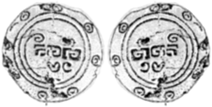Kawi script
| Kawi | |
|---|---|
 | |
| Type | |
| Languages | Indonesian Languages, Philippine Languages, Malaysian Languages |
Time period | c. 8th–16th century |
Parent systems | |
Sister systems |
Balinese Batak Baybayin Kulitan Buhid Hanunó'o Lontara Old Sundanese Rencong Rejang Tagbanwa |
| Brahmic scripts |
|---|
| The Brahmic script and its descendants |
|
Northern Brahmic
|
Aksara Kawi (from Sanskrit kavi "poet")[1] is the name given to the writing system originating in Java and used across much of Maritime Southeast Asia from the 8th century to around 1500 AD.[2] It is a direct derivation of the Pallava script brought by traders from the ancient Tamil Kingdom of the south Indian Pallava dynasty in India,[3] primarily used for writing Sanskrit and Old Javanese language. Kawi is the ancestor of traditional Indonesian scripts, such as Javanese and Balinese, as well as traditional Philippine scripts such as Baybayin.[1]
Overview
Kawi is derived from the Pallava script mentioned by scholars of Southeast Asian studies such as George Coedès and D. G. E. Hall as the basis of several writing systems of Southeast Asia. The Pallava script was primarily used to write middle Tamil.
The earliest known texts in Kavi date from the Singhasari kingdom in eastern Java. The more recent scripts were extant in the Majapahit kingdom, also in eastern Java, Bali, Borneo and Sumatra.
The scripts are abugidas, meaning that characters are read with an inherent vowel. Diacritics are used, either to suppress the vowel and represent a pure consonant, or to represent other vowels.
The literary genre written in this alphabet is called Kakawin.
A well-known document written in Kawi is the Laguna Copperplate Inscription, found in 1989 [4] in Laguna de Bay, in the metroplex of Manila, Philippines. It has inscribed on it a date of Saka era 822, corresponding to May 10, 900 AD,[5] and is written in Old Malay containing numerous loanwords from Sanskrit and a few non-Malay vocabulary elements whose origin is ambiguous between Old Javanese and Old Tagalog.[6] This document, among other discoveries made in recent years in the country such as the Golden Tara of Butuan and 14th century pottery and gold jewellery artifacts found in Cebu, is highly important in revising the ancient history of the Philippines.
 |
The "Butuan Ivory Seal" (The left hand image is the seal itself; the right hand image shows how a print from the seal would appear.) The Kawi lettering reads "Butban". The three square seal style characters are BA, TA and NA; the leftward curl underneath BA is the /u/ vowel diacritic, changing the syllable to BU; the small heart-shaped character under TA is the subscript conjunct form of BA which also removes the default /a/ vowel from TA; the large curl to the upper right is the Kawi virama, which indicates the default /a/ vowel on NA is not pronounced. The three blocks of characters together read "[Bu][Tba][N-]. In both Balinese script and Javanese script, which are descended from Kawi, the word is spelled in a very similar pattern, using a similar /u/ diacritic, conjunct form for B, and virama. |
See also
Notes
- 1 2 Prelimininary proposal for encoding the Kawi script in the UCS
- ↑ De Casparis, J. G. Indonesian Palaeography: A History of Writing in Indonesia from the beginnings to c. AD 1500, Leiden/Koln, 1975
- ↑ http://www.ancientscripts.com/kawi.html
- ↑ "Expert on past dies; 82". Philippine Daily Inquirer. 2008-10-21. Retrieved 2008-11-17.
- ↑ Laguna Copperplate Inscription - Article in English
- ↑ Postma, Antoon. (1992). The Laguna Copper-Plate Inscription: Text and Commentary. Philippine Studies vol. 40, no. 2:183-203
External links
| Wikimedia Commons has media related to Kawi script. |
- Tiongson, Jaime F., (2008). Laguna copperplate inscription: a new interpretation using early Tagalog dictionaries. Bayang Pinagpala. Retrieved January 14, 2012.
| ||||||||||